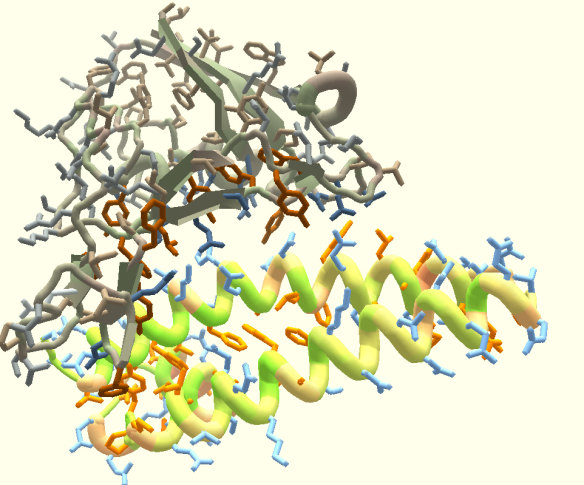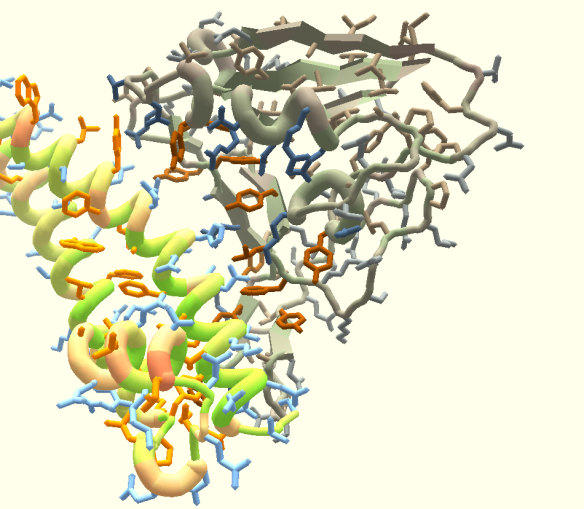This was published 4 years ago
This game helps scientists design COVID drugs. They want you to play
By Liam Mannix
Stuck at home and feeling helpless in the face of a global pandemic?
You don’t need to be.

An image from Foldit. The coronavirus spike is shown (in grey) binding to the human receptor protein (in colour)Credit: Foldit
If you like solving puzzles, scientists want your help to start designing potential drugs to combat the coronavirus using a game you can play on your computer.
The citizen-science project, known as Foldit, hopes to start turning designs into actual drugs within a month.
Asking untrained people to design drugs sounds like pie in the sky. But the science behind the project is very real, independent researchers told The Age and The Sydney Morning Herald.
“The lab behind it, led by Professor David Baker, is possibly the best equipped in the world to design a protein,” says Associate Professor Ashley Buckle, a protein engineer based at Monash University.
“This lab is the best in the world.”
“The approach has been shown to work. Not always. But there is a good chance it will."
Foldit is among the world’s most-successful citizen-science projects.
It challenges users to solve 3D puzzles by finding ways to fit complex shapes together, or build their own new shapes – a cross between 3D Tetris and Minecraft.
Those shapes are proteins, the building blocks of the human body.
The program, originally co-ordinated by Professor Baker’s Institute for Protein Design at the University of Washington, has been running for more than 10 years and has a string of successes behind it – such as building a protein 20 times more efficient than one designed by scientists, or cracking the shape of another protein important to AIDS drugs. Scientists had been trying to do it for a decade but Foldit players did it in days.
How does solving puzzles bring us closer to a COVID-19 cure?
Our cells are covered in "cellular receptors" – think of them as little antennas that listen for signals from the body.

Another angle on the problem.Credit: Foldit
SARS-CoV-2, the virus that causes COVID-19, has a long spike that is perfectly shaped to stick on to one particular receptor, like a key sliding into a lock.
But if you could make a drug that sticks onto that spike, in effect gumming it up, you could stop the virus infecting people.
“It just has to stick to the virus – it does not have to do much else,” says Dr Brian Koepnick, one of the scientists working on the project.
Foldit presents players with a 3D model of SARS-CoV-2’s spike. The goal: build a protein that will stick onto it.
Looking for some good news?
We could all do with some good news right about now. That’s why we have launched The Good News Group, a Facebook group where we’ll share uplifting, inspiring and positive stories and invite members to do the same. Join the group here.
It’s much harder than it sounds. Your drug needs to bend around and stick to the extremely complex structure of the spike.
Natural selection has finely honed the spike so it sticks perfectly onto our cells – so your drug needs to stick even more perfectly to the spike.
The problem is often left to supercomputers, which can use raw computing power to quickly try millions of different shapes.
But they have their limits.
The total number of possible shapes for even a tiny protein is “more than the atoms in the universe”, says Professor Joel Mackay, a protein expert at the University of Sydney.
Humans can learn from their failures and have something supercomputers don’t: creativity. That’s what gives Foldit its real power.
So far, they’ve had a few thousand people submit solutions for the COVID puzzle using different shapes. But every extra person helps, says Dr Koepnick. The team will select the best protein shapes soon and begin building them in the lab within the next few weeks.
Then they will be tested against SARS-CoV-2 in a lab – and if they find one that works, the drug will go on to other scientists for further testing and possible clinical trials.
“There is a chance this works,” says Professor Mackay. “It’s a little bit more out there than a straightforward vaccine design program, but it’s still totally scientifically solid.”
To have a go yourself, go to fold.it